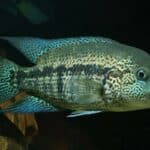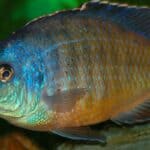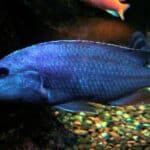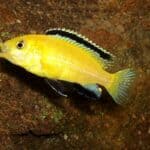The scientific name for Jewel Cichlids is Hemichromis bimaculatus. It is a member of the Cichlidae family.
This species is found all across Africa’s Western coast. They can be seen from South Guinea to Central Liberia. They are mostly found in small streams and canals. They like areas with lots of surface vegetation and overhanging foliage.

Care Guide
Tank Size
The tank for a single Jewel Cichlid should be a minimum of 110 liters, or 24.2 gallons. The tank should be 48 inches (120 cm) long, 12 inches (30 cm) deep, and 12 inches (30 cm) high at minimum.
Tank Mates
Jewel Cichlids can be kept with other animals, although you should be wary. Larger Alestiid tetra species such as Loricariids, Synodontis catfish, and Congo tetras are the best tank mate choices.
If you have a very large tank, African Cichlids such as Steatocranus are good tank mates for Jewel Cichlids.
Same Species Tanks
Jewel Cichlids are best kept in pairs, although there is no guarantee that this will work out well for you or them. Purchasing just 2 Jewel Cichlids will often mean that the weaker fish dies. The best results are achieved by purchasing a whole group of juvenile Jewel Cichlids. This will allow a pair to form naturally, and hopefully will not result in too many deaths.
Water Parameters
The water in the Jewel Cichlid tank should be between 72 and 82 degrees Fahrenheit. This is about 22 to 28 degrees Celsius.
The pH of the water should be between 6.0 and 7.8 for optimal fish health.
The hardness of the water should be between 4 and 18 dH.
What To Put In Their Tank
Jewel Cichlids need a roomy aquarium with lots of little spots to hide in. This will allow them to seek sanctuary and reduce instances of aggressive behaviors. Clay flower pots, rock caves, and loose driftwood are all good decorative tank ornaments.
It is also a good idea to plant some aquatic vegetation in dense regions. This provides a food source and a hiding place for the fish. Be aware that the Jewel Cichlids are very good at digging. This means that any plants added to the tank must be potted or strongly rooted in.
Their tank will also need a sandy substrate at the base to allow the Jewel Cichlids to dig as they would in the wild. Do not use rougher substances than sand as this could injure them.
Common Diseases
Swim bladder disease affects the fish’s swim bladder. This is a sac contained within the abdomen that helps the fish to float in the water. When they develop this disease, the fish cannot stay submerged in the water.
Malawi bloat is an aquarium fish disease that causes abdominal swelling and rapid breathing. It can also cause liver and kidney damage.
Tuberculosis is a relatively fatal disease that can be transmitted to humans through open wounds. Your fish will stop eating and become very lethargic.
Cotton wool disease is a fungal disease that causes fuzzy white growths on the heads of your fish. Unless the water quality in your tank is poor this should not be an issue.
Hole in the head disease is also known as hexamita. It is believed to be caused by a parasite coupled with mineral imbalances and poor water quality.
White spot (Ich) is a parasitic disease. It is highly infectious and if one fish displays symptoms, you must treat the entire tank.
Gill flukes are caused by a parasitic flatworm infecting the fish’s gills. This makes the gills turn red and develop a thick coating of slime, making it hard for the fish to breathe.
Food And Diet
Jewel Cichlids are not particularly fussy eaters. They will eat almost anything that you offer to them, making your life easier. For the best results, you should feed them live foods as this will improve the Jewel Cichlids natural colors.
You should also feed your fish vegetable or spirulina flakes, or blanched spinach. This will get in some vitamins and minerals to their diet.
Juvenile Jewel Cichlids should be fed microworms and brine shrimp nauplii.
Lifespan
The average Jewel Cichlid will live for around 5 years. In some rare cases, captive Jewel Cichlids have been known to live for up to 7 years, although this is rare.
Their lifespan will vary according to the level of care you provide them with and the suitability of their environment. The aggressive nature of these fish means that many will die prematurely either through stress or injury.
Appearance
As the name suggests, Jewel Cichlids are brightly colored in all sorts of gemstone hues. The most common color is the red Jewel Cichlid – they have a bright orange or red body and light blue-green spots all over the entire body. Their fins commonly have light blue-green stripes on them.
Jewel Cichlids tend to have a narrow and pointed body shape. The dorsal fin runs down about ⅔ of the length of their body, stopping just before it reaches the caudal fin. They have trim and shallow anal fins.
The heads of a Jewel Cichlid slants up from the mouth and curves into their back. This appears as a pronounced bump when the fish are younger but tends to smooth out as the fish age.
Size
Jewel Cichlids tend to measure around 6 inches or 15cm in length when kept in captivity. Their wild counterparts have been known to measure up to a foot in length. There is no real suggestion as to why this is.
Behavior And Temperament
Jewel Cichlids are very territorial fish and have an aggressive streak, particularly during spawning periods.
Breeding
For Jewel Cichlids to breed, you will need to allow the fish to pair up naturally. It is a good idea to add some large rocks to the tank to act as spawning sites for the fish. The conditions of the tank will also need to be adjusted. The pH must be between 6.5 and 7.0, set to a temperature of between 75 to 82 degrees Fahrenheit.
As soon as you notice a pair of fish forming, you must immediately remove all other fish from the tank. The pair will begin to kill them off if you do not do this. The paired Jewel Cichlids will remain together for the rest of their lives.
When the fish are ready to breed, you will notice that their color becomes much more intense and vivid. Their behavior will become more aggressive and they will seek out a spawning spot. This is often a flat and slightly angled rock, the glass side of the tank, or a flowerpot.
Once they have chosen their spawning spot, you will notice they begin to clean it well. The males are very insistent in their pursuit of the female and may harass her to death if she is not ready to mate. You should keep a close eye on the fish during this time.
The female will lay a line of eggs and then move away from them. This allows the male fish to swoop in and fertilize them. The fish can lay and fertilize up to 600 eggs at a time like this.
A mere 48 hours later the eggs will have started to hatch. The male’s job at this point is to protect the spawning spot while the female’s job is to take care of the eggs. Sometimes the fish will switch roles. You will also notice both the male and female fish digging small dips into the substrate around the spawning spot.
Just 72 hours after the eggs have been fertilized, they should all have hatched. The female fish then moves their babies into the pits that they have just made. This movement happens a few more times before the babies are old enough and capable of swimming by themselves. This often takes around a further 24 hour period.
The parent fish will look after their young for the first month of their lives. After this point, you will need to remove the young fish to allow the parents to spawn again if they wish.
Gender Differences: Male vs. Female
It is very difficult to tell the difference between the males and females of this species. The best way to tell is by looking at the caudal (tail) fins.
In males, the tail fin commonly has a blue pattern that resembles a net or web in the center. The adult males will also have much more pointed dorsal (back) fins.
The females tend to be slightly smaller but have a fuller body than their male counterparts.
Fun Facts
Jewel Cichlids are the most monogamous fish out there. They bond intensely during the mating process and are likely to stay together for life.
Jewel Cichlids are native to Africa and there are 11 different species in this genus, Hemichromis. These are angolensis, bimaculatus, cerasogaster, elongatus, exsul, fasciatus, frempongi, guttatus, letourneuxi, lifalili, and stellifer.








